The Burrow

Maybe you love the countryside and dream of open skies and green fields. Maybe the cyberpunk dystopia of dense urban sprawl is getting to you, and you need some peace and quiet. Perhaps you’re looking for a holiday home. Or, perhaps you’re willing to move far from the city if it means getting into the property market.
Whatever your reason, general consensus is that regional cities and towns will be less expensive than the big capital cities. Could a tree change be your ticket to property ownership?
As Australian home loan comparison experts, we’ve analysed select cities and towns from nine different countries across the globe, and according to our latest research, it isn’t so clear cut.
One might assume that a regional city – a township that falls outside a major state capital – would be more affordable. However, that’s not necessarily the case. Depending on where you look, the state capital might be the cheapest option for housing.
This was especially the case for the USA (except Texas and Nebraska), New Zealand, South Africa, Greece and Mexico. Countries where the example regional locations were consistently more affordable included Australia, Italy, France, Spain and Canada.
The sections below have country-specific breakdowns that dive deeper into the example locations.
Turning to Australia now, we looked at a range of regional cities and towns in New South Wales, Queensland, Victoria, Western Australia and Tasmania. There were a few locations that were more expensive than the state capitals, but most locations had a lower average house price.
For New South Wales, the bush towns Taree, Tamworth and Dubbo had the biggest differences in their average price to the state capital, Sydney (133%, 129% and 123% less expensive, respectively). In Victoria it was Traralgon (91% less) and Mildura (89% less), while in Western Australia the remote mining town Kalgoorlie had the biggest decrease (113% less than Perth’s average).
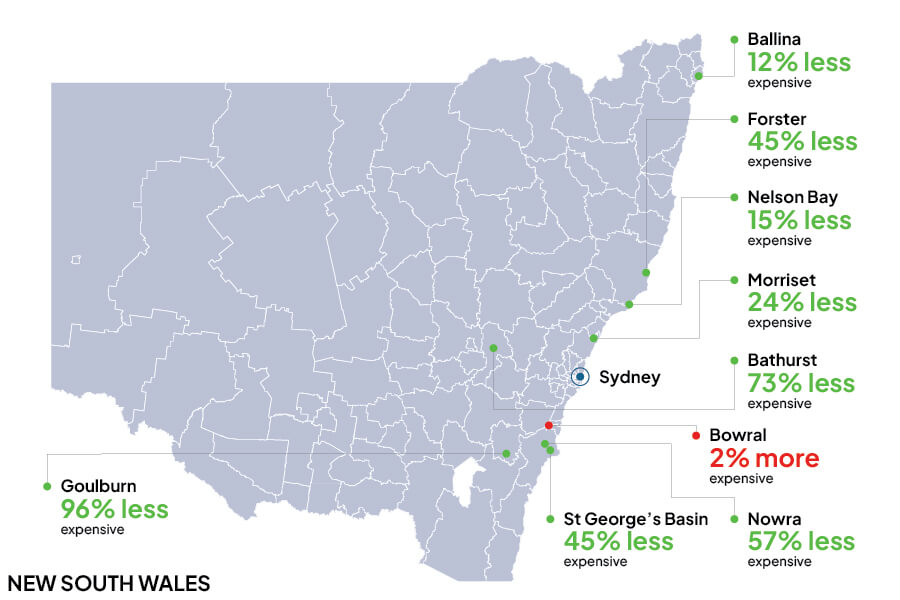
The more affordable regional towns in Queensland were Maryborough (108% less on average than the capital Brisbane) and Rockhampton (81% less), located close to the beach but far north of the capital.
The locations that were more expensive than their capitals were Bowral in New South Wales (2% more expensive), the Gold Coast and Sunshine Coast in Queensland (15% and 18% more expensive respectively), and Busselton in Western Australia (15% more).
Bowral is a beautiful town in the Southern Highlands of New South Wales, and boasts many expensive country mansions, wineries, restaurants and boutique shops, which could be why its average is more expensive than Sydney’s. The Gold Coast, Sunshine Coast and Busselton are all beachfront cities with stunning ocean views, which drives up prices.
Click here to view all locations from Australia and their price difference to their state capital average.
We examined selected cities and towns from California, Florida, Nebraska, New York, Oregon and Texas, to see what their price difference was in comparison to the capital city.
In Texas we looked at 10 cities, including the capital, Austin. All nine other locations were more affordable, with Round Rock having an average that is 22% lower than Austin’s, and Big Spring having the biggest difference at 298% less.
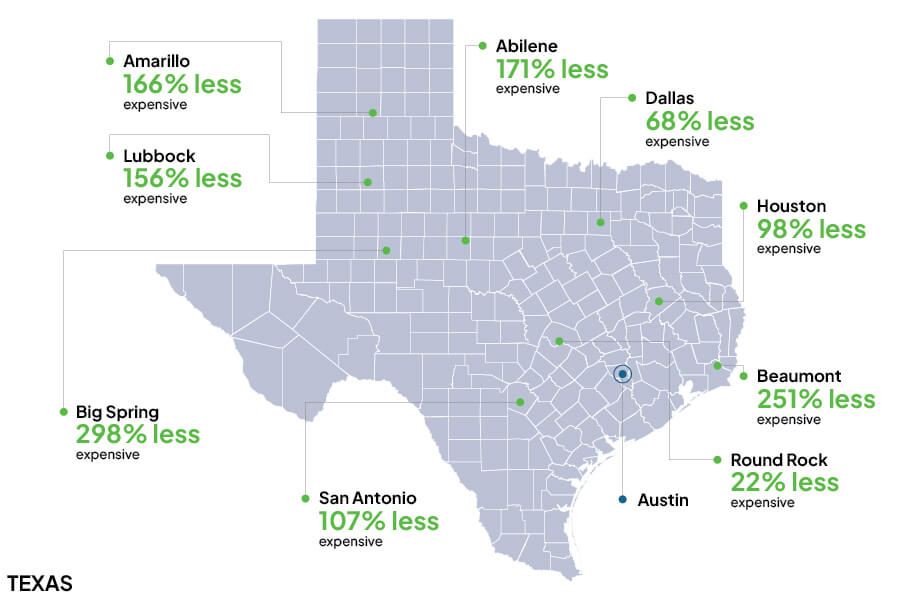
In contrast, Florida’s capital Tallahassee was the most affordable out of the 10 cities we examined there. The difference in average prices compared to other locations ranged from 4% more expensive for Jacksonville to 51% more expensive in Miami.
Most of Nebraska’s regional locations were more affordable, except for Norfolk which was 6% more expensive. Similarly, New York’s regional towns were more affordable than the state capital Albany, except for New York City itself, which was 60% more expensive on average in comparison.
California and Oregon were interesting cases. Both states had a lot of cities that were more expensive than the state capital. More affordable options were out there however, such as Hayfork (122% less), Red Bluff (56% less), Fresno (26% less) and Bakersfield (24% less) in California – or Roseburg and Scottsburg in Oregon, which were 22% and 28% less respectively.
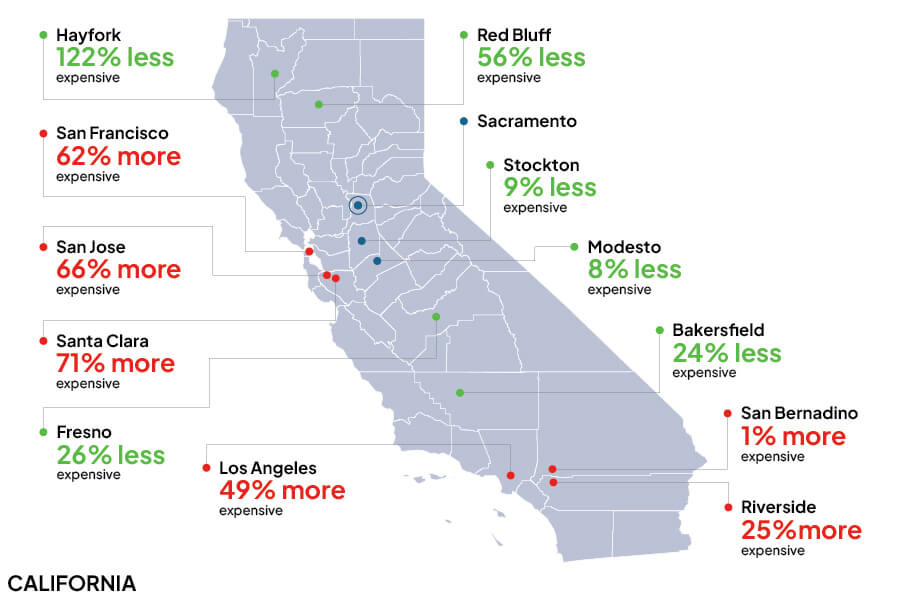
There are different reasons why the state capitals are so different in price to other towns, depending on location. For example, Florida is full of beautiful popular coastal cities that are main draws for tourism and provide ocean-front views. It’s a similar story in California, though that is also coupled with Los Angeles being the studio hub of Hollywood, and San Francisco being the tech capital of the US.
Click here to view all locations from the US and their price difference to their state capital average.
For Canada we chose towns from Alberta, British Columbia, Ontario and Quebec. While price comparisons in Alberta and British Columbia were a mixed bag, Ontario and Quebec were more consistent when comparing regional cities to the capitals.
In Alberta, Fairview’s price average was 71% lower than the capital of Edmonton’s, while Medicine Hat was 5% less. Meanwhile, Spruce Grove was 23% more expensive and Calgary was 29% more expensive.
The chosen locations from British Columbia were quite a mix of more affordable and more expensive in comparison to the capital Victoria. For those willing to live in the small, remote community of Bella Coola, homes there are 321% more affordable than Victoria. In contrast, the skiing hub of Whistler was 54% more expensive than the capital.
For Ontario, all locations were more affordable than the capital Toronto, with the difference ranging from 36% for Hamilton to 434% for the regional town of Hearst. Likewise, all but one city in Quebec were more affordable than the capital Quebec City, except for the major city Montreal, which was 22% more expensive on average.
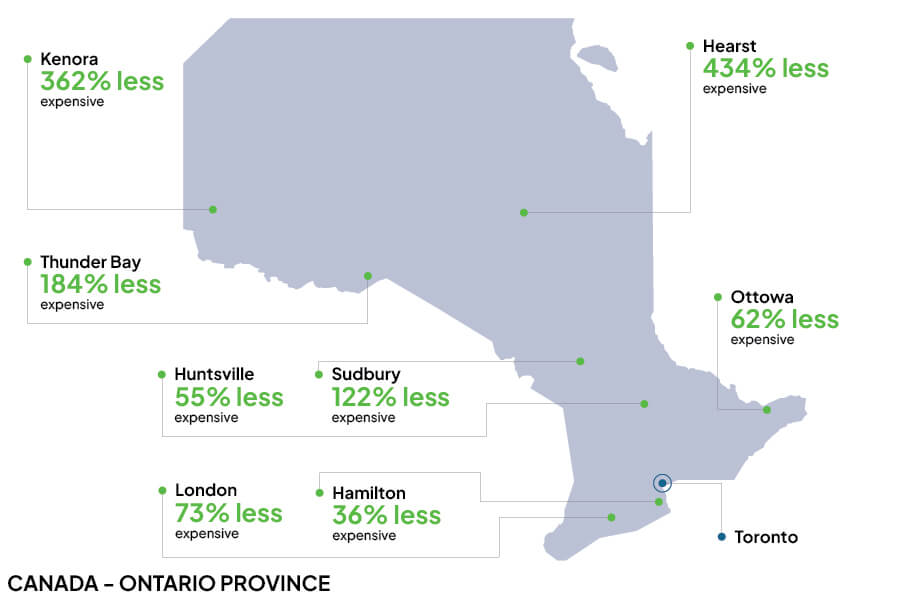
Canada is a beautiful country, but the northern landscape outside the major cities can be harsh, with most people living in large cities in the south, away from the Arctic Circle and towards the border with America.
Click here to view all locations from Canada and their price difference to their state capital average.
For France, we selected cities and towns from six provinces: Auvergne-Rhône-Alpes, Bourgogne-Franche-Comté, Centre-Val de Loire, Île-de-France, Normandy, and Occitania.
France is known for its beautiful countryside, and in almost all locations analysed these towns were more affordable than their provincial capitals – sometimes quite significantly cheaper.
In Auvergne-Rhône-Alpes, Annecy was 29% more expensive than the capital Lyon, but Vichy was 137% more affordable, and Issoire was 182% more affordable in comparison. In Occitania, the large coastal city of Montpellier was 6% more expensive than the capital Toulouse, but all the rest were more affordable, with five towns being more than 100% more affordable on average – Cahors, Castres (both 103% less), Auch (104% less), Rodez (138% less) and Saint-Gaudens (147% less).
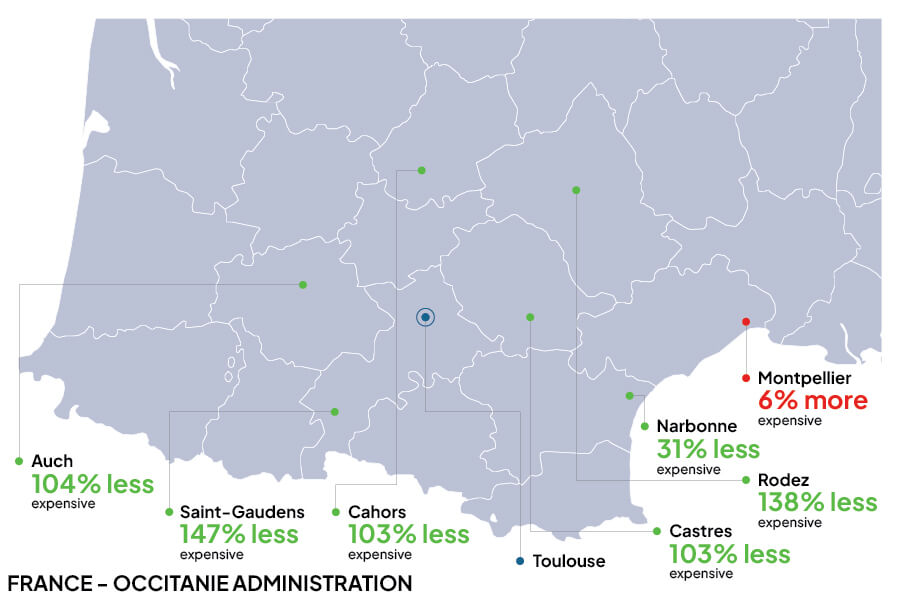
These beautiful historic medieval towns offer French countryside living at a more affordable price than their state capitals, and could be great locations for people able to find work in their area, commuting or working remotely.
Click here to view all locations from France and their price difference to their provincial capital average.
We examined six provinces in Italy and 29 cities across the country. These provinces were Campania, Emilia-Romagna, Lazio, Lombardy, Tuscany and Veneto. In each of them, every city or town was more affordable than the provincial capital, to various amounts – apart from one exception.
The port city of Livorno in Tuscany was 14% more expensive than the capital of Florence, and it was the only regional city we looked at in Italy that had a higher average cost. On the other hand, Grosseto was 177% less, followed by Arezzo at 121% less.
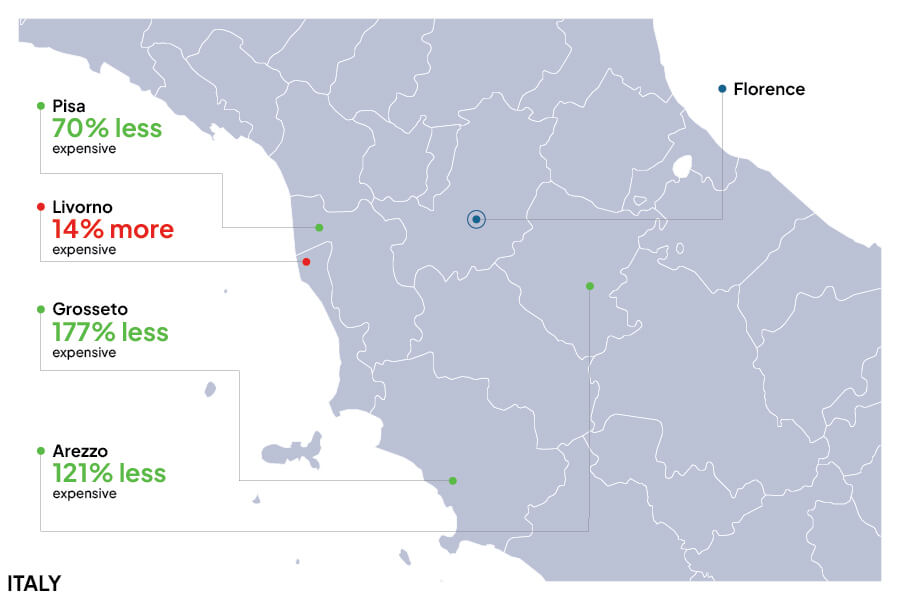
Lombardy had some of the biggest differences between the capital of Milan and other cities and towns. The biggest differences were among Cremona, which had an average that was 205% cheaper than Milan, and Varese which was 191% less.
Click here to view all locations from Italy and their price difference to their state provincial average.
For Spain, we examined several towns and cities across five provinces: Barcelona, Madrid, Seville, Toledo and Valencia.
Barcelona province had the biggest differences between average prices for regional towns to the city of Barcelona, with Igualada’s average house price being 348% lower than the capital. Manresa had the next biggest difference at 305%.
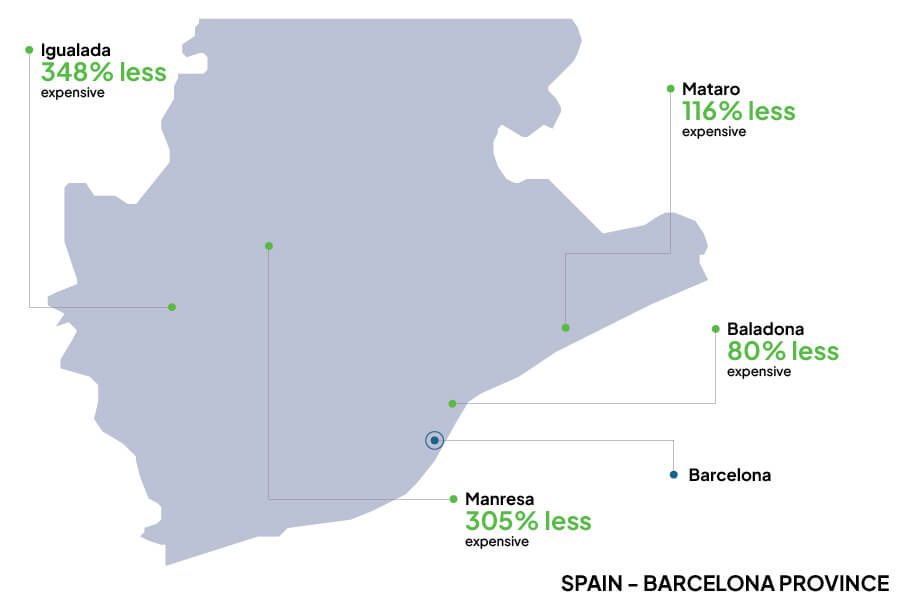
The province of Seville had the lowest differences between the city of Seville and its regional towns. Écija had the biggest increase in affordability at 41%, followed by Pilas at 34%. Carmona and El Garrobo were only 5% and 3% respectively, while Dos Hermanas was the only Spanish city we examined that was more expensive than the capital, with an average price that was 12% more expensive on average than the city of Seville.
Across Spain there are many affordable country towns with prices much lower than the capitals – but it comes with a price. While unemployment has come down in recent years from a high of 26.94% in 2013, it’s still quite high at 11.27% as of July 2024.1 The houses may be much more affordable, but work opportunities could be harder to find in less populated regional cities.
Click here to view all locations from Spain and their price difference to their provincial capital average.
While other European countries followed the trend of regional cities being cheaper than the capital, the examples we looked at in Greece were not. We looked at select cities and towns in Attica, Crete, Peloponnese and Central Greece.
The province of Attica was the only Greek province where there were more affordable averages in regional locations, with half of the cities being cheaper than the capital of Athens and the other half being more expensive. Keratea had an average price 51% lower than Athens, while Piraeus was 22% more affordable. In contrast, Glyfada was 62% more expensive, while Marousi was 21% more expensive on average.
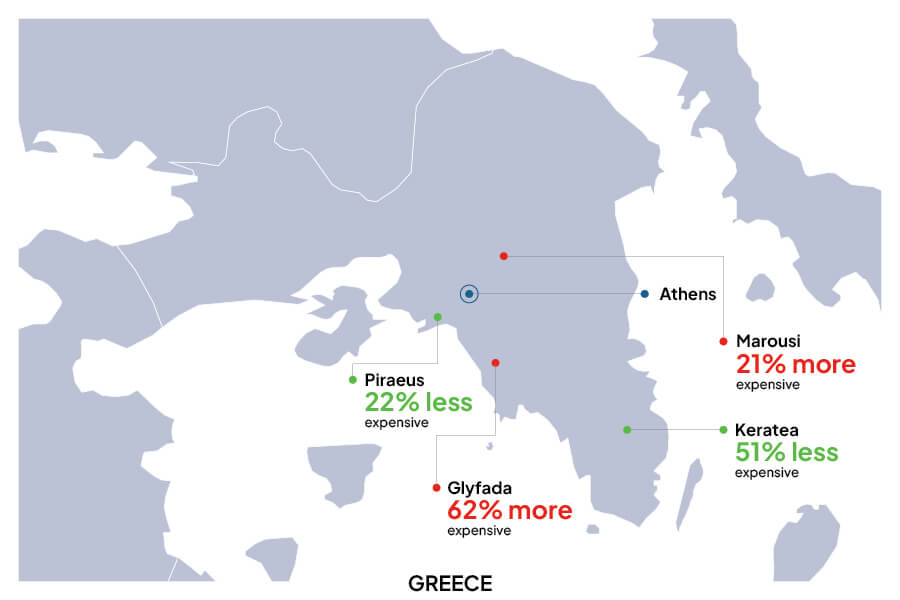
Some cities with the biggest increases on the capital included the cities of Nafplion and Kranidi in Peloponnese, which were 73% and 64% more expensive than the capital Tripoli. Kranidi is a ritzy location known for high-price celebrity homes – essentially the Greek version of Beverly Hills.
Nafplion on the other hand is a beautiful seaside Greek tourism city and this has impacted house prices, as many residences are rented out for tourists, reducing available housing for prospective homeowners.2 This is a problem impacting many locations within Greece, causing several regional cities to become more expensive than their capitals.
Click here to view all locations from Greece and their price difference to their provincial capital average.
New Zealand had a small selection of cities and towns examined across four regions: Auckland, Canterbury, Otago and Wellington.
For Wellington and Canterbury, it was consistently the case where regional towns were cheaper than their capitals (except for Porirua in Wellington, which was 5% more). For Auckland and Otago, it was a real mixed bag of results.
In Auckland, Helensville and Waiuku were more affordable than the city of Auckland (18% and 22% less respectively), but Silverdale and Karaka were more expensive (30% and 32% more). In Otago, Kaitangata had an average price 124% less than the capital Dunedin, while the town of Roxburgh had an average 38% less. In contrast, the skiing and adventure sports capital of New Zealand, Queenstown, had an average house price 64% higher than Dunedin.
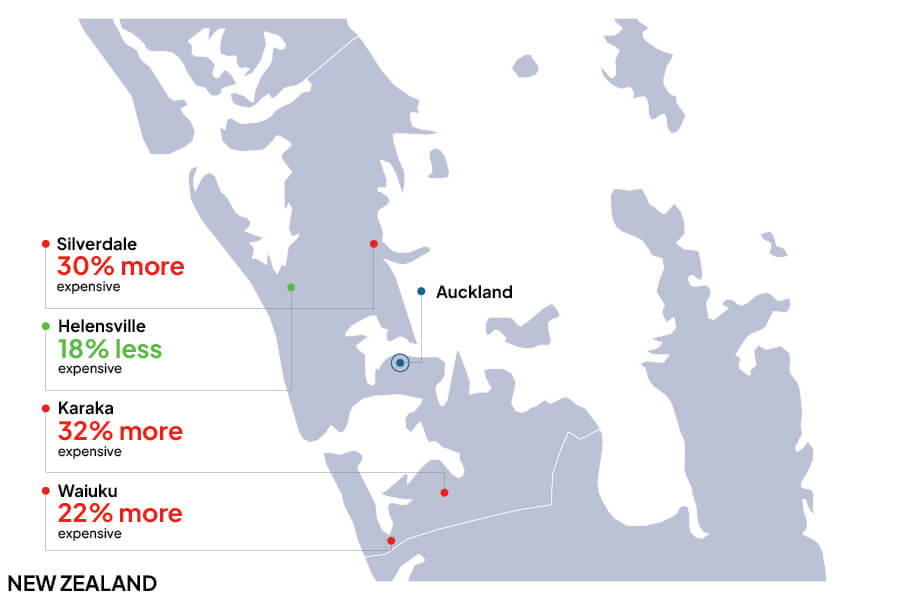
Click here to view all locations from New Zealand and their price difference to their regional capital average.
The last nation we examined was South Africa, with examples taken from Free State, Gauteng, KwaZulu-Natal and Western Cape. Price averages varied wildly in comparison to the provincial capitals across each of the four regions.
In Free State, Welkom and Lejweleputswa were more affordable on average than the capital Bloemfontein (48% and 65% less respectively), while Motheo had the same average price. In Guateng, the city of Vanderbijlpark had an average price 13% lower than Johannesburg’s average house price, while Krugersdorp was only 3% less. Pretoria was 13% more expensive than Johannesburg, while Sandton was 32% more expensive.
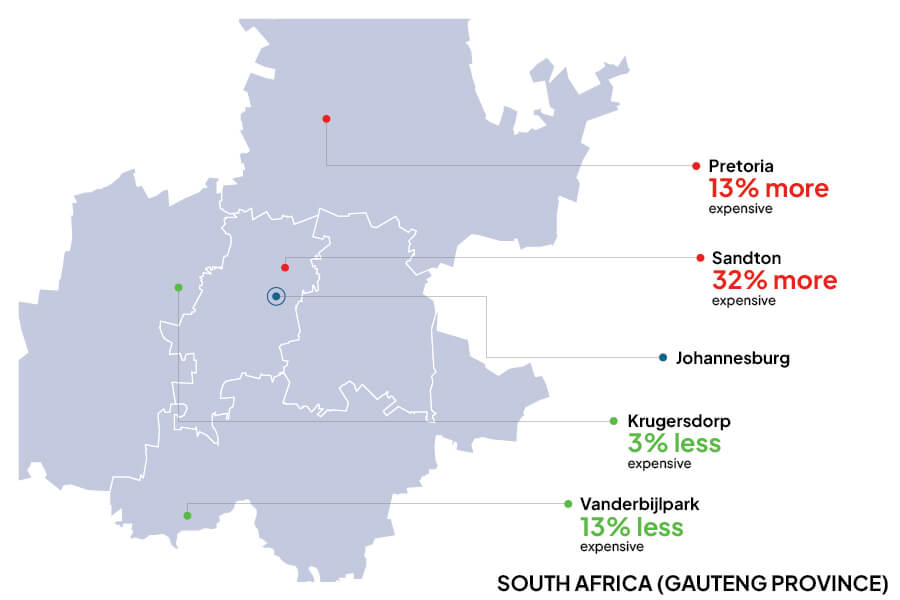
In Western Cape, all other regional cities chosen were more expensive than the capital Cape Town, with differences ranging from 14% more expensive for Paarl to 47% more expensive for Franschoek. In KwaZulu-Natal, the city of Newcastle was the regional town with the biggest decrease out of all locations we examined in South Africa, being 149% cheaper than the capital Pietermaritzburg. Durban was 8% more expensive, and Richards Bay was 24% more expensive.
Across the country there is a variety of factors that impact why a location might be more expensive – local tourism and the demand for holiday housing reducing residential housing options, safety and security, and other desirable elements like oceanfront views or nice country homes as opposed to dense urban sprawl.
Click here to view all locations from South Africa and their price difference to their provincial capital average.
Compare the Market’s General Manager of Money, Stephen Zeller, notes that if you’re willing to cast your net wide and choose a regional location to find more affordable properties, it’s important to establish your budget.
“Some people start with a location first, then set a budget and see what listings they can find. If you’re less worried about exactly where you go, it’s important to establish a budget first. You could do this by using a borrowing power calculator, to set a useful benchmark to help you when you go house hunting,” Mr Zeller explains.
“Besides looking at real estate listings for properties within your budget, you could find property and suburb reports to learn more about a specific area and its housing market.”
Once you’ve got a budget, you can compare home loans to weigh up interest rates, fees and features from available loans and lenders – and this could save you a good amount of money over the course of a mortgage.
“Whether you’re looking for a tree change, want a bit more peace and quiet and space in the countryside, or chasing a holiday home, you should always compare your home loan options before you dive in. The lower the interest rate, the less you’ll pay over the course of your home loan. Even a small dip in percentage points can save you thousands by the end of your mortgage.
“However, you should also note other loans which could have very useful features like offset accounts, where you can reduce interest charges by saving money in the account, but still being able to access it if you need to.”
For Australians looking to buy in Australia – from the ‘Big Smoke’ to the bush – Compare the Market’s home loan service provides ongoing mortgage broker support as well as other free property and suburb reports and free credit checks.
For this article, we selected 10 countries and picked a number of states, provinces or regions within each country to examine. We then sourced the average price of a residential home for the capital of that state/region/province and did the same for other cities and towns outside the capital’s jurisdictions. We then compared the difference between the average residential house price of the regional location with its capital to calculate the percentage difference.
Prices were converted into USD and AUD on 24/10/24 and are subject to change. Pricing data for the total of 329 cities was sourced between 21/10/24 and 24/10/24, and the AUD price conversion was used for the purpose of calculating percentage differences between prices.
Due to data limitations, Australia, Canada, the USA and New Zealand used average AUD dollar values for homes, while France, Italy, Greece, Spain, South Africa and Mexico used average AUD per square metre figures.
Prices were sourced from:
References: